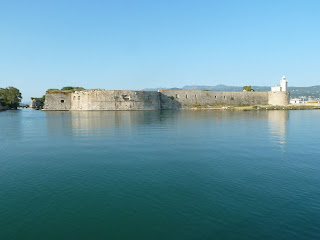The winds looked promising so we said our goodbyes to ASTAKOS and set sail for Missalonghi, our first stop in the Gulf of Patras on the Eastward Journey to The Aegean.
Disappointingly once we were on our way the winds dropped and it was like a millpond. We did hoist the sails for part of the journey passing many islets on our way south and eventually turned east into The Gulf of Patras heading for Missalonghi, a large town built on salt marshes with a dramatic backdrop of mountains.
We approached the marina via a canal with colourful fishing shacks on either side.
Having secured a good berth for the night the guys lit up the barbecue and we dined on traditional fare of Souvlaki whilst haunting Greek music drifted over the water from a distant wedding party.
MISSALONGHI TO PATRAS
Alan had originally planned to sail to Trizonia but the famous Westerly Winds, which were supposed to help us on this leg, turned into strong Easterlies eventually achieving gale force with 37 knots of wind. It was a slow uncomfortable trip, the waves pounding against the bow, as the boat motored making an average of only 2-3 knots, however we all felt safe in the central cockpit even if the helmsmen did have frequent showers of saltwater. Six long hours later we decided to pull in at Patras Marina, once tied up we desalted the boat and ourselves with long showers.
Patras is the third largest town in Greece, a bit of a concrete grid but it did have some character with lots of wonderful old fashioned shops (often no more than windowless corridors lined by dozens of drawers) and a fairly modern central area which seemed to be patronized by some of the 40,000 students who study here. Greek Ironmongeries are a great favourite of mine - classic one on the right.
The marina area was quite smart, a parade of up-market cafes and bars with a feel of the Cote D’Azur.
Our stay turned into 3 nights as the winds continued to gust with huge white caps racing down the Gulf, we felt fortunate to be safely tucked up in the Marina. One day we climbed up to an old Citadel which looked down over the town from a steep hill.
– 193 steps later we reviewed the site and were rather disappointed in the ruins however the view was spectacular.
On roaming further we became aware of cordoned off excavations – we later discovered that this whole area had been the site of an important Roman theatre and sports complex.
PATRAS TO TRIZONIA
Finally we awoke to a beautiful day of ‘milky’ blues and soft winds and set forth to travel under the Rion-Andirrion 2,252 m. long suspension bridge (second only in length to the Millau Viaduct in France). The bridge dramatically improves access to and from the Peloponese which previously could be reached only by ferry or via the Isthmus of Corinth at its extreme east end.
It’s hugely impressive; men working on the bridge looked the size of tiny ants and put it all the more in perspective. There’s a strict procedure for going under the bridge – we had to inform the bridge master of the boat’s name and height before getting the go ahead.
Once safely through we hoisted the sails and with the wind from behind we were able to achieve a good ‘gull-wing’ setting and enjoyed a beautiful sail to the island of Trizonia.
Trizoni lies a short distance from the mainland in the North. It’s a quiet cluster of houses and a couple of hotels, a very unspoilt relaxing little place.
We ambled along some of the coastline......
and ended up having a drink at a taverna in the small local port watching the last rays of sun on the fishing boats
TRIZONIA TO ITEA
With gusts of 30-35 knots we sailed with a couple of reefs in the foresail and still achieved an average of 7 knots, the weather was magical helping to make this sail of 21 miles the best so far. I noticed that the mountains were looking more barren and arid than those on the Western Coast.
At Itea we secured a good alongside berth and once the boat was tied up we sped off to the bus terminal to get information for our trip to Delphi the next day.































 Farewell to KIONI
Farewell to KIONI




















